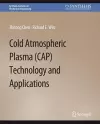
Cold Atmospheric Plasma (CAP) Technology and Applications
2 authors - Paperback
£54.99
Dr. Zhitong Chen is a Professor at National Innovation Center for Advanced Medical Devices, China. He did his postdoctoral training in the Plasma and Space Propulsion Lab of Dr. Richard E. Wirz at the University of California, Los Angeles. He received his Ph.D. in Mechanical and Aerospace Engineering from the George Washington University, where he worked under the supervision of Dr. Michael Keidar. He received his M.Sc. and B.Sc. in Engineering Mechanics at the Institute of Mechanics, Chinese Academy of Sciences, and Mechanical Engineering at Northeast Agriculture University, respectively. His research interests focus on plasma physics, plasma applications, and medical devices.Dr. Richard E. Wirz is a Professor in the Mechanical and Aerospace Engineering Department at the University of California, Los Angeles (UCLA), holds a joint faculty affiliate appointment at NASA JPL, and is an advisor to the United States Air Force and Space Force. He is the Director of the UCLA Plasma and Space Propulsion Laboratory and Energy Innovation Laboratory. He received his Ph.D. from the California Institute of Technology (Caltech). His research interests focus on plasmas, materials, and space electric propulsion (EP). He developed the world’s first miniature noble gas ion thruster (MiXI) which is an enabling technology for precision formation flying of large multi-spacecraft interferometers, and critically enhancing for a wide range of new missions. His lab has also developed the first self–consistent, multidimensional hybrid plasma discharge model which has been used successfully in the design of ion thrusters of all sizes. His research in the area of plasma-material interactions (PMI) has lead to the discovery of the “plasma-infusion” properties of plasma-facing complex surfaces, which is a new material regime for high-energy density applications from fusion energy to propulsion. His Energy Innovation Laboratory has developed new approaches to wind and solar energy including the “biplane” wind turbine and sulfur-based thermal energy storage. Most recently, his lab investigated the effect of cold atmospheric plasma (CAP) on cancer therapy, especially for cancer immunotherapy, and virus disinfection. He has authored over 200 publications, 2 NASA Tech Briefs, and has several patents in these areas. He has received the AFOSR Young Investigator Award and the Northrop Grumman Excellence in Teaching Award.